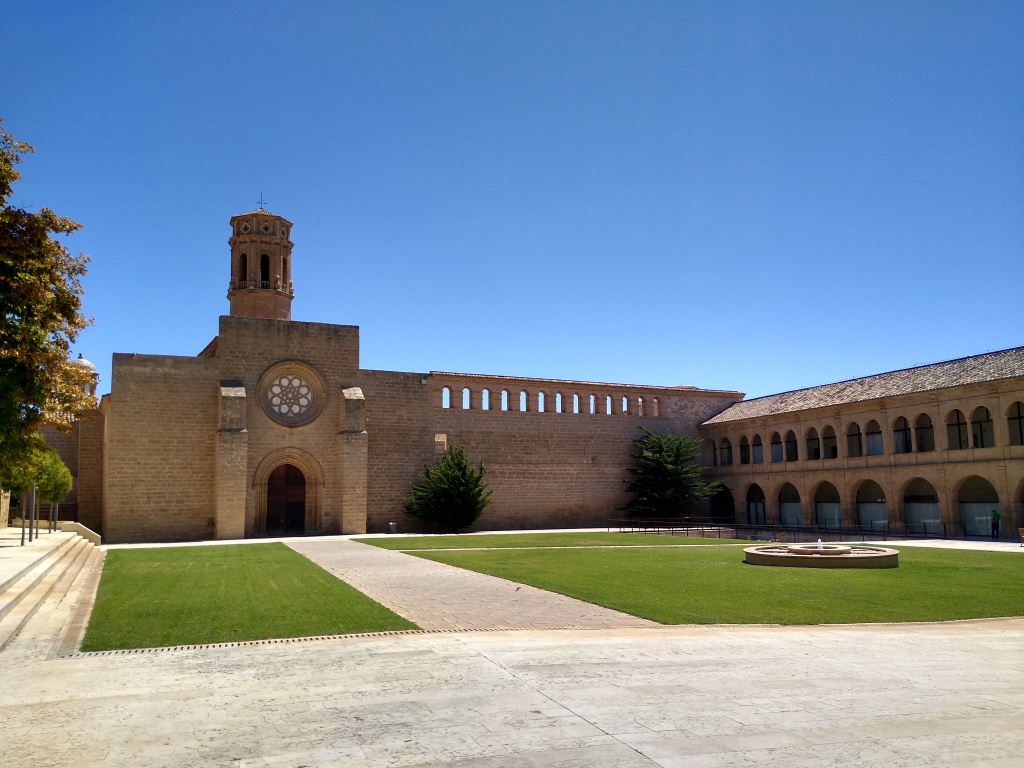SINCE THE MIDDLE OF THE XIII CENTURY, WHEN KING JAIME I CONQUERED THE BALEARIC AND VALENCIA, MAKING SAFE THE NAVIGATION THROUGH THE WESTERN MEDITERRANEAN, THE JACOBEO WAY OF EBRO WAS AND STILL IS ONE OF THE MOST POPULAR ROUTES TO CROSS THE OLD KINGDOM
This Jacobean route enters Aragón through Fabara and crosses into Navarre through Mallén, with an obligatory stop in Zaragoza, where the legend originated, and supposedly Virgin Mary appeared to the Apostle Santiago.
The Ebro river has, for centuries, formed a veritable axis of communication between the Mediterranean Sea and the Castilian plateau. Cultures of all kind, including the Romans, used their valley as an essential mean of transport. The Jacobean pilgrims also followed these paths, pictured on the below image,

The Ebro is the second longest river in Spain. Its waters have shaped a network of roads that pilgrims have used since the beginning of the second millennium. Its footprint has been left on numerous Jacobean witnesses, on historical documentation of pilgrims and safe passages, and on testimonies of an old hospital network, which today begins to resurface again.
The Camino Jacobeo del Ebro has its symbolic beginning at the springs of the Ebro, in a monument elevated on a small dune dedicated to the virgins of this Jacobean route. The route always goes close to the Ebro to Xerta, where pilgrims shorten the great meander of the Ebro river until they meet again at the Mequinenza reservoir.
This path is relatively well signposted and runs in many sections along the GR-99 Camino del Ebro route. The latter is longer, since it tends to go much closer to the river while the Jacobean tends to shorten in the various meanders.
The Camino del Ebro has the city of Zaragoza and its grand church of El Pilar as its central axis. Tradition tells us that in this same place the Virgin Mary appeared in mortal flesh on January the 2nd, 1940, to encourage him in his evangelization of the peninsula, offering him a pillar on which to build a church. This same pillar is the one venerated today in the basilica.

This route is very pleasant in terms of unevenness, but it lasts in terms of shadows, which are scarce at all stages. It is an easy bike route.
The Camino Jacobeo del Ebro has accommodation in all possible stages, although pilgrim hostels are scarce now.
Monarchs, nobles and military orders protected the pilgrims and founded oratories, shelters and hospitals on the route, now disappeared, but of which the current name of many streets is remembered, as well as the dedication of chapels and parish churches.

The great river Ebro offers a great variety of surprising vegetation and fauna. In addition, on its banks, it is possible to admire extraordinary Roman remains, such as Fabara’s mausoleum, one of the best preserved examples of roman funerary art, or the impressive roman Colonia Celsa, not to forget the beautiful Cistercian Monastery of Nuestra Señora de Rueda.
The river port of Zaragoza had intense traffic since Roman times, and a multitude of boats crossed it from the interior of the Peninsula towards the sea and in the opposite direction, until well into the 20th century.

Mar de Aragón 
Mar de Aragón 
Mar de Aragón 
Mar de Aragón 
Mar de Aragón 
Mar de Aragón 
Caspe 
Caspe 
Caspe 
Caspe 
Mar de Aragón 
Mar de Aragón 
Mar de Aragón 
Mar de Aragón 
Mar de Aragón 
Mar de Aragón 
Mar de Aragón
The Camino Jacobeo del Ebro, as it passes through Aragón, consists of 9 pilgrim stages:
STAGE 1. Fabara-Caspe. Distance: 20 km. Duration: 4 h 50 m.
STAGE 2. Caspe-Escatrón. Distance: 29 km. Duration: 5 h 50 m.
STAGE 3. Escatrón-Gelsa. Distance: 34 km. Duration: 5 h 20 m.
STAGE 4. Gelsa-Fuentes de Ebro. Distance: 21 km. Duration: 4 h 20 m.
STAGE 5. Sources of Ebro-La Cartuja. Distance: 21 km. Duration: 4 h 20 m.
STAGE 6. La Cartuja-Zaragoza. Distance: 8 km. Duration: 1 h 40 m.
STAGE 7. Zaragoza-Torres de Berrellén. Distance: 17 km. Duration: 3 h 30 m.
STAGE 8. Torres de Berrellén-Luceni. Distance: 20 km. Duration: 4 h.
STAGE 9. Luceni-Mallén. Distance: 20 km. Duration: 4 h.
Check our experiences below or contact us if you rather want a bespoke experience for your group or family visiting through some of these places, we are looking forward to hear from you and more importantly, having you onboard!











